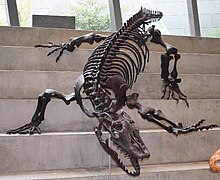Megalania
| Megalania | |
|---|---|

| |
| Megalania skeletal reconstruction on Melbourne Museum steps | |
| Scientific classification | |
| Domain: | Eukaryota |
| Kingdom: | Animalia |
| Phylum: | Chordata |
| Class: | Reptilia |
| Order: | Squamata |
| Family: | Varanidae |
| Genus: | Varanus |
| Species: | †V. priscus
|
| Binomial name | |
| †Varanus priscus | |
| Synonyms | |
| |
Megalania (Varanus priscus) is an
Megalania is thought to have had a similar ecology to the living Komodo dragon (Varanus komodoensis). The youngest fossil remains of giant monitor lizards in Australia date to around 50,000 years ago.[2] The first indigenous settlers of Australia might have encountered megalania,[3] and been a factor in megalania's extinction.[4][2][5] While originally megalania was considered to be the only member of the titular genus "Megalania", today it is considered a member of the genus Varanus, being closely related to other Australian monitor lizards.
Taxonomy

Sir
Megalania is included within Varanus because its morphology suggests that it is more closely related to some species of Varanus than others, so excluding V. priscus from Varanus renders the latter genus an
Phylogeny

Several studies have attempted to establish the
Size

The lack of complete or nearly complete fossil skeletons has made it difficult to determine the exact dimensions of megalania.[7] Early estimates placed the length of the largest individuals at 7 m (23 ft), with a maximum weight of approximately 600–620 kg (1,320–1,370 lb).[11] In 2002, Stephen Wroe considerably downsized megalania, suggesting a maximum length of 4.5 m (15 ft) and a weight of 331 kg (730 lb) with averages of 3.5 m (11 ft) and 97–158 kg (214–348 lb),[12] decrying the earlier maximum length estimate of 7 m (23 ft) as exaggerations based on flawed methods. In 2009, however Wroe joined other researchers in raising the estimate to at least 5.5 m (18 ft) and 575 kg (1,268 lb).[13]
In a book published in 2004, Ralph Molnar determined a range of potential sizes for megalania, made by scaling up from dorsal vertebrae, after he determined a relationship between dorsal vertebrae width and total body length. If it had a long, thin tail like the lace monitor, then it would have reached a length of 7.9 m (26 ft), while if its tail-to-body proportions were more similar to that of the Komodo dragon, then a length around 7 m (23 ft) is more likely. Taking the maximal 7 m (23 ft) length, he estimated a weight of 1,940 kg (4,280 lb), with a leaner 320 kg (710 lb) being average.[7]
Palaeobiology

Megalania is the largest terrestrial lizard known to have existed. Judging from its size, it would have fed mostly upon medium- to large-sized animals, including any of the giant marsupials such as Diprotodon, along with other reptiles and small mammals, as well as birds and their eggs and chicks.[citation needed] It had heavily built limbs and body, a large skull complete with a small crest between the eyes, and a jaw full of serrated, blade-like teeth.[8]
Some scientists regard with skepticism the contention that megalania was the only, or even principal, predator of the Australian Pleistocene megafauna.
Komodo dragons, megalania's closest relative, are known to have evolved in Australia before spreading to their current range in Indonesia, as fossil evidence from Queensland has implied.[15][16] If one were to reconstruct the ecosystems that existed before the arrival of the humans on Australia, reintroducing Komodo dragons as an ecological proxy of megalania to the continent has been suggested.[17]
A study published in 2009 using Wroe's earlier size estimates and an analysis of 18 closely related lizard species estimated a sprinting speed of 2.6–3 m/s (9.4–10.8 km/h). This speed is comparable to that of the
The scales of megalania would possibly be similar to those of their extant relatives, possessing a honeycomb microstructure and both durable and resilient to water evaporation.[19]
Venom
Along with other
Extinction
The youngest remains of the species date to the Late Pleistocene, with the youngest remains possibly referrable to the species being a large osteoderm dating to approximately 50,000 years ago from the Mount Etna Caves National Park in central-eastern Queensland.[2] A study examined the morphology of nine closely related extant varanid lizards and then allometrically scaled and compared them to V. priscus, found that the musculature of the limbs, posture, muscular mass, and possible muscular composition of the animal would most likely have been inefficient when attempting to outrun the early human settlers who colonised Australia during that time.[4] Considering many other species of Australian megafauna went extinct around the same time, either due to human predation or being outcompeted by them, the same can be assumed for megalania.
Confrontations between megalania and early Aboriginal Australians may have inspired tales of fearsome creatures such as the whowie.[7]
References
- ^ JSTOR 108688.
- ^ .
- ISBN 9784405073432.
- ^ PMID 26893606.
- ^ "Wildfacts - Megalania, giant ripper lizard". BBC. 2008. Archived from the original on 2011-12-27. Retrieved 2012-03-22.
- ISBN 978-0-253-34366-6.)
- ^ ISBN 978-0-253-34374-1.
- ^ ISBN 978-0-253-34366-6.
- ^ .
- ^ Lee MSY (1996). "Possible affinities between Varanus giganteus and Megalania prisca". Memoirs of the Queensland Museum. 39: 232.
- ^ Hecht, M. (1975). "The morphology and relationships of the largest known terrestrial lizard, Megalania prisca Owen, from the Pleistocene of Australia". Proceedings of the Royal Society of Victoria. 87: 239–250.
- doi:10.1071/zo01053. Archived from the originalon 2013-01-03. Retrieved 2012-03-22.
- ^ PMID 19451641.
- doi:10.1071/ZO99006.)
{{cite journal}}: CS1 maint: multiple names: authors list (link - PMID 19789642.
- ^ "Australia was 'hothouse' for killer lizards". Australian Broadcasting Corporation. 30 September 2009. Retrieved 30 September 2009.
- ISBN 0-8021-3943-4.
- .
- PMID 27615821.
- S2CID 23137302.
- S2CID 4386245.
- ^ Barry C (2009). "Komodo Dragons Kill With Venom, Researchers Find". National Geographic News. Archived from the original on May 21, 2009. Retrieved 2012-03-22.
